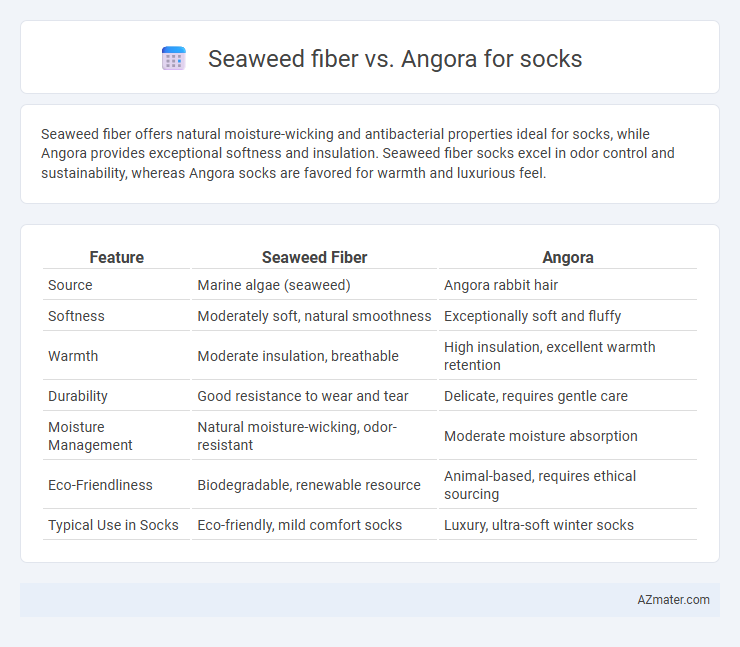Seaweed fiber offers natural moisture-wicking and antibacterial properties ideal for socks, while Angora provides exceptional softness and insulation. Seaweed fiber socks excel in odor control and sustainability, whereas Angora socks are favored for warmth and luxurious feel.
Table of Comparison
| Feature | Seaweed Fiber | Angora |
|---|---|---|
| Source | Marine algae (seaweed) | Angora rabbit hair |
| Softness | Moderately soft, natural smoothness | Exceptionally soft and fluffy |
| Warmth | Moderate insulation, breathable | High insulation, excellent warmth retention |
| Durability | Good resistance to wear and tear | Delicate, requires gentle care |
| Moisture Management | Natural moisture-wicking, odor-resistant | Moderate moisture absorption |
| Eco-Friendliness | Biodegradable, renewable resource | Animal-based, requires ethical sourcing |
| Typical Use in Socks | Eco-friendly, mild comfort socks | Luxury, ultra-soft winter socks |
Introduction to Alternative Sock Fibers
Seaweed fiber and Angora are innovative alternatives to traditional sock materials, offering unique benefits for comfort and sustainability. Seaweed fiber provides natural moisture-wicking and antimicrobial properties, making it ideal for odor control and breathability in socks. Angora, derived from Angora rabbits, delivers exceptional softness and warmth, enhancing the luxury and insulation of sock fabrics.
What Is Seaweed Fiber?
Seaweed fiber, also known as seaweed fabric or seaweed cellulose, is a sustainable textile material derived from marine algae, prized for its natural antimicrobial and moisture-wicking properties that enhance sock comfort and hygiene. Unlike Angora, which is sourced from Angora rabbits and renowned for its exceptional softness and insulation, seaweed fiber promotes breathability and odor resistance, making it ideal for active wear and sensitive skin. Seaweed fiber's eco-friendly production process offers a renewable alternative to traditional animal fibers while maintaining durability and lightweight feel for high-performance socks.
What Is Angora Fiber?
Angora fiber, derived from the Angora rabbit, is prized for its exceptional softness, warmth, and lightweight properties, making it an ideal choice for luxurious socks. Unlike seaweed fiber, which offers natural moisture-wicking and antibacterial benefits due to its marine origin, Angora provides superior insulation and a silky texture that enhances comfort during cold weather. The unique hollow structure of Angora fibers traps heat efficiently, giving socks made from this material unmatched thermal regulation compared to seaweed fiber blends.
Sustainability: Seaweed Fiber vs Angora
Seaweed fiber socks offer a sustainable alternative by utilizing renewable marine resources that regenerate rapidly without harming ecosystems. Angora wool, sourced from Angora rabbits, raises ethical concerns related to animal welfare and requires intensive care, impacting sustainability negatively. Seaweed fiber's biodegradable properties and lower environmental footprint make it a more eco-friendly choice compared to traditional Angora socks.
Comfort and Softness Comparison
Seaweed fiber socks offer natural moisture-wicking properties and a smooth texture, providing breathable comfort and reducing odor during extended wear. Angora socks are renowned for exceptional softness and warmth, made from fine rabbit hair that feels silky against the skin but may cause sensitivity for some users. Choosing between seaweed fiber and angora depends on prioritizing cooling breathability versus insulating, luxurious softness.
Durability and Longevity in Socks
Seaweed fiber socks exhibit strong durability due to their natural cellulose structure, which resists wear and tear while maintaining softness and breathability. Angora socks, made from fine rabbit hair, offer exceptional warmth but tend to have lower abrasion resistance, leading to quicker pilling and reduced lifespan. Seaweed fiber generally outperforms Angora in longevity for socks, making it a more resilient option for everyday use.
Moisture-Wicking and Breathability
Seaweed fiber socks excel in moisture-wicking due to their natural hydrophilic properties, efficiently drawing sweat away from the skin and promoting quick drying. Angora wool socks offer superior breathability with fine, hollow fibers that enhance air circulation and temperature regulation. For activities requiring high moisture management and ventilation, seaweed fiber provides a lightweight, fast-drying advantage, while Angora excels in maintaining warmth without sacrificing airflow.
Allergy and Sensitivity Considerations
Seaweed fiber offers hypoallergenic properties, making it suitable for individuals with sensitive skin or allergies, as it naturally resists bacteria and irritants. Angora wool, while soft and warm, often triggers allergic reactions due to lanolin content and fine fibers that can cause itching or skin irritation. Choosing seaweed fiber socks minimizes allergy risks and enhances comfort for sensitive wearers.
Ethical and Cruelty-Free Choices
Seaweed fiber offers an eco-friendly and biodegradable alternative to Angora, which involves animal harm during harvesting. Choosing seaweed fiber socks supports sustainable fashion by reducing animal cruelty and promoting renewable resources. Ethical consumers prioritize seaweed fiber for its cruelty-free production and minimal environmental impact compared to Angora wool.
Cost and Accessibility of Each Fiber
Seaweed fiber offers a sustainable and cost-effective alternative to Angora, with lower production expenses due to its rapid renewability and abundant availability in coastal regions. Angora fiber, derived from Angora rabbits, tends to be more expensive and less accessible because of limited farming operations and labor-intensive harvesting processes. Consumers seeking affordable and eco-friendly sock materials often prefer seaweed fiber, while Angora remains a premium choice favored for its softness and warmth despite higher costs.

Infographic: Seaweed fiber vs Angora for Sock
 azmater.com
azmater.com